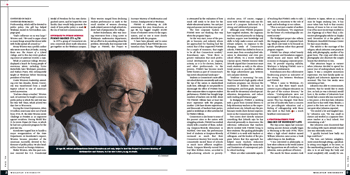Outreach to Public Schools
 In 1979 a group of Connecticut citizens concerned about math education got together on the Wesleyan campus. Their worries ranged from declining student performance in math to the small number of women choosing math-related careers to high school students’ lack of preparation for college.
In 1979 a group of Connecticut citizens concerned about math education got together on the Wesleyan campus. Their worries ranged from declining student performance in math to the small number of women choosing math-related careers to high school students’ lack of preparation for college.
Robert Rosenbaum, who was nearing retirement from a long career in Wesleyan’s mathematics department, led an effort to do something about the problem. Eventually, that response took shape as PIMMS, the Project to Increase Mastery of Mathematics and Science, headquartered at Wesleyan.
PIMMS is celebrating its 25th anniversary this year. Rosenbaum, at age 88, has logged roughly 40,000 hours of volunteer service to the organization, and no one is more closely identified with the program.
“I have been pleased, and to some extent astonished, that PIMMS has continued as it has,” he says. “That pleasure is attenuated by the realization of how much still needs to be done for the whole educational system. You can’t just stop and assume you’ve done your part.”
The first corporate backers of PIMMS were not thinking that way when the program began.
“At the very start, some of the people in business and industry whom we approached for funding had the notion that if they supported PIMMS for a couple of summers, that ought to be all that Connecticut needed,” Rosenbaum says. “Now there is greater realization that such professional development is an ongoing activity, as it is for doctors, lawyers, and other professionals. In the process, PIMMS has become much better known as part of Connecticut’s top-notch educational landscape.”
Students in Connecticut’s more affluent school districts consistently rank near the top of the nation in standardized math tests. Although it’s not possible to disentangle the effect of PIMMS from other measures taken to improve student performance, PIMMS has brought large numbers of teachers into its fold. About 750 PIMMS Fellows have at least two years’ experience with the program, another 1,500 have shorter experiences, and thousands of teachers have participated in workshops or other activities led by PIMMS Fellows.
Connecticut is also home to some of the poorest cities in the nation with struggling schools. PIMMS has worked closely with a number of these, including Simpson-Waverly Elementary in Hartford. Over time, the performance level of students at Simpson-Waverly increased so much that their Connecticut Mastery Test results now consistently exceed those of schools in much more affluent neighborhoods. Simpson-Waverly earned federal Blue Ribbon status, accorded to high-achieving schools in povertystricken areas. Of course, engagement with PIMMS was only one element of a program fashioned by a strong and celebrated principal.
Although some PIMMS programs have targeted students, the organization has focused primarily on helping teachers acquire new knowledge and skills to help make science and math vibrant subjects. In response to the changing needs of Connecticut’s schools, PIMMS has shifted its focus in recent years from secondary-level education to elementary and even preschool efforts. In a recent Hartford Courant op-ed, PIMMS Director Mike Zebarth argued that Connecticut must reach students as early in the educational process as possible to address the huge achievement gap between rich and poor districts.
“Evidence is increasing,” he says, “that Connecticut’s high quality school readiness programs can decrease the numbers of children held back in kindergarten and first grade, decrease the need for elementary school specialeducation designations, and reduce early reading performance gaps.”
In Bridgeport, PIMMS is working with a grant from General Electric to help elementary teachers in the impoverished inner city. Zebarth says the preliminary results show distinct improvement on the Connecticut Mastery Test.
Test scores don’t directly measure something that Zebarth says he has observed personally in classrooms: the infectious enthusiasm that teachers who’ve worked with PIMMS bring to their students. The guiding philosophy of PIMMS is to work with teachers as colleagues, and the leaders of the program believe that this approach has helped many teachers rediscover enthusiasm for tackling the many trials and frustrations of contemporary public school teaching.
There are other untestable aspects of teaching that PIMMS seeks to cultivate, such as sensitivity to the role of math and technology in our culture.
“This is not just a matter of aesthetics,” says Rosenbaum. “It’s important for the future of a technologically oriented society.”
The Bridgeport project also reflects the changing nature of corporate funding, which now tends to be focused on specific problems rather than general program support.
PIMMS has always relied heavily on corporate and foundation support, which waxes and wanes with the economy or changing corporate priorities. To provide ongoing stability, Wesleyan is helping PIMMS raise a $2-million endowment.
Rosenbaum sees this collaborative fundraising project as indicative of the strong ties between Wesleyan and PIMMS.
“When I came to Wesleyan, it’s fair to say that there wasn’t much interest in pre-collegiate education on the part of the science division,” he relates. “Undergraduates were not encouraged to think of teaching as a career. This has changed. Now there are lots of faculty who have a concern for pre-collegiate education and a feeling of colleagueship with those who work in that field. It’s a much healthier environment.”
